#2018 embedded projects
Explore tagged Tumblr posts
Text
My Personal Ethic as a Nature Interpreter
My connection to nature comes from the small, quiet, moments in my everyday life. The warmth of a summer breeze after a long, tiring day, or the cheerful chirping of birds outside my window in the morning—these simple experiences make me feel alive, and nature has always been embedded in those fleeting, trivial moments.

As I’ve said before, my role in nature interpretation extends beyond simply sharing information. Nature interpretation is about promoting connections between people and the environment, encouraging sustainable action, and ensuring that diverse audiences feel included in these experiences. My beliefs, responsibilities, and approaches as an interpreter are shaped by my values and the guiding principles outlined in our textbook, which emphasizes the importance of paying attention to learning styles and finding ways to incorporate these for diverse audiences (Beck et al., 2018).
My Beliefs as an Interpreter
One of my foundational beliefs is that nature interpretation should be immersive, engaging, and deeply meaningful. I believe that authentic experiences in nature have the power to inspire awe and a sense of responsibility. As stated by Beck et al. (2018), "experiences of awe occur precisely in the authentic settings where interpreters work.” This highlights the importance of ensuring that interpretive efforts remain grounded in real, tangible connections to the environment.
Additionally, I believe that interpretation should be accessible and inclusive. Taking diversity into account is crucial for success, as different cultures, abilities, and perspectives shape how people relate to nature (Beck et al., 2018). Thus, as an interpreter, I must acknowledge these differences to create meaningful experiences for all visitors.
Finally, I believe that interpretation is a lifelong learning process, and visitors should have opportunities to continuously engage with nature over time. The concept of "lifetime learning curricula" from our textbook reinforces that interpretive sites should aim to be repeat destinations, encouraging people to return and deepen their understanding (Beck et al., 2018). It should be a place that one never forgets, and the interpreter in charge is the most important aspect in attaining this goal.
My Responsibilities in Interpretation
Nature interpreters have a set of important responsibilities that shape their work, and in this section, I will outline the key duties that I believe are essential in guiding my development as an interpreter. First, helping the audience build lasting connections through authenticity is crucial in ensuring the success of an interpretive program. Authenticity is the defining aspect of any interpretive site, whether leading a guided hike, or designing an exhibit, an interpreter must ensure that my presentations remain true to the ecological, historical, and cultural integrity of a place (Beck et al., 2018). Authentic experiences cultivate trust and allow visitors to gain genuine connections with nature (Beck et al., 2018).
Second, I believe as an interpreter, we have a large responsibility to encourage public advocacy (Beck et al., 2018). Sharing the work of conservation groups, highlighting pressing environmental issues, and inspiring visitors to take action, is essential. This could involve promoting citizen science projects, encouraging ethical wildlife interactions, or discussing ways to support local conservation efforts. Ultimately, interpretation is the foundation for developing deep connections with nature, and once this is accomplished, public advocacy is the next most important thing to encourage citizen engagement and inspire real change regarding environmental conservation and sustainability efforts.
Lastly, something that I strongly believe in is education through interpretation. As Beck et al. (2018) mentions, the next generation's involvement with nature doesn’t begin in adulthood, but rather during early-to-middle childhood. This means as an interpreter, my responsibility includes creating engaging, age-appropriate programs that inspire young learners to appreciate nature. By integrating hands-on experiences, storytelling, and interactive activities, I can ensure that children build positive relationships with the environment from a young age. This early connection fosters a lifelong appreciation for nature, encouraging future generations to become informed advocates and responsible stewards of the environment.
My Personal Approach to Interpretation
While there are many ways to approach interpretation, I find that certain strategies align best with my strengths and personal style. First, appealing to emotion is one of the most effective ways to inspire environmental stewardship (Beck et al., 2018). Rather than overwhelming audiences with facts and figures, I would aim to craft compelling stories that evoke curiosity and empathy. For example, sharing the life story of a migratory bird—its long journey, the threats it faces, and the importance of conservation efforts—can be more impactful than simply stating population statistics. Personally, I find this type of engagement is most effective in encouraging people to reflect upon their own roles in nature, ultimately driving and inspiring tangible change.
Next, community engagement is something that I think is very important, for the benefit of the agency, the resource, and the online community itself (Beck et al., 2018). As an interpreter, I would hope to create programs that allow for direct community participation, such as habitat restoration projects, local nature walks, and citizen science initiatives. By engaging people in hands-on conservation, I can foster a deeper sense of ownership and responsibility for the environment.
Lastly, an interpreter should understand that not all visitors engage with nature in the same way—some may prefer quiet reflection, while others enjoy interactive, fast-paced experiences. Thus, my approach in interpretation would be adaptive, incorporating varied techniques to ensure accessibility and inclusion. As I mentioned, individuals have different styles of learning, and it is important to create programs that encourage inclusion and have the possibility to reach diverse, multi-generational audiences (Beck et al., 2018). Providing multilingual resources, tactile learning experiences, and alternative presentation methods for different learning styles will be key to making interpretation more effective for different audiences. Interpretation is about inspiring curiosity, engagement, and action—and by creating programs that welcome and resonate with all visitors, we can help cultivate a more environmentally conscious and connected society.
Closing Notes
Developing my personal ethic as a nature interpreter means embracing authenticity, inclusivity, and emotional engagement. As I continue to grow in this field, I will remain committed to creating meaningful connections between people and the natural world, fostering environmental stewardship in both formal and informal settings.
With this, I end this blog—a process that truly has deepened my understanding of nature interpretation and my role within it. Though this may be my final post, my commitment to lifelong learning and sharing the wonders of the natural world will continue. I hope that through these posts, myself and others have inspired each other to seek our own connections with nature, to embrace curiosity, and to advocate for the landscapes and ecosystems that sustain us all.
To close, I leave you with a picture of my dog heavily side-eyeing a mischievous squirrel in my backyard—to remind you that even in the smallest, quietest, everyday moments, there is curiosity and connection to nature waiting to be noticed.

References:
Beck, L., Cable, T.T., Knudson, D.M. (2018). Interpreting Cultural and Natural Heritage: For a Better World. Sagamore Publishing LLC. https://sagamore.vitalsource.com/books/9781571678669
9 notes
·
View notes
Text
Exploration of the now-offline Far Cry 5 official websites
Part 17: Grace Armstrong
Recovered content
Grace, the second Gun for Hire to be introduced, had a description on the American website on (or even before) July 13th, 2017:

THE SNIPER GRACE ARMSTRONG Grace Armstrong is an expert sniper who served one tour in Afghanistan, and now works as a weapons instructor at her family’s shooting range in the Holland Valley. The Project at Eden’s Gate was a growing presence, but nothing she took seriously. Things came to a head when the shooting range was taken over by the Project and local police refused to help.
The archived page from February 9th, 2018, shows she then became The Marksman instead of The Sniper, and her description was modified as well:

THE MARKSMAN GRACE ARMSTRONG Grace Armstrong is an expert sniper who has won a bronze medal at the US Olympics, served multiple tours in Afghanistan, and returned home to work as a weapons instructor alongside her father at the family’s shooting range in the Holland Valley. The Project at Eden’s Gate was a growing presence, but nothing she took seriously at first. However, things came to a head when the shooting range was violently taken over by The Project, while local police refused to help. The resulting chaos led to the death of Pops. At that moment, something snapped inside Grace. She buried her father, unpacked her sniper rifle, and went hunting for the members of Eden’s Gate.
“Learn More” redirected to the article “The Hope County Resistance” from February 8th, 2018:
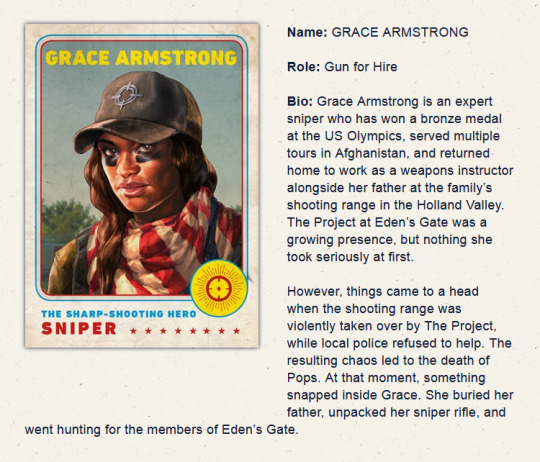
GRACE ARMSTRONG - The Sharp-Shooting Hero - SNIPER Name: GRACE ARMSTRONG Role: Gun for Hire Bio: Grace Armstrong is an expert sniper who has won a bronze medal at the US Olympics, served multiple tours in Afghanistan, and returned home to work as a weapons instructor alongside her father at the family’s shooting range in the Holland Valley. The Project at Eden’s Gate was a growing presence, but nothing she took seriously at first. However, things came to a head when the shooting range was violently taken over by The Project, while local police refused to help. The resulting chaos led to the death of Pops. At that moment, something snapped inside Grace. She buried her father, unpacked her sniper rifle, and went hunting for the members of Eden’s Gate.
This is what her information box looked like at least between March 27th, 2018, and February 7th, 2020:

The text is identical to the previous version, and the embedded video was this one:
youtube
Here is her description on the European site, where she remained The Sniper and not The Marksman:

GRACE ARMSTRONG THE SNIPER Grace Armstrong is an expert sniper who served multiple tours in Afghanistan, and now works as a weapons instructor at her family’s shooting range in the Holland Valley. The Project at Eden’s Gate was a growing presence, but nothing she took seriously. Things came to a head when the shooting range was taken over by the Project and local police refused to help.
“More Info” was a link to the Cosplay Reference Guide from June 2017:

GRACE ARMSTRONG Meet Grace, a local weapons instructor, long-range sniper and Army Veteran. With nothing left to lose, she’s ready to take on Eden’s Gate.
And the video was this one:
youtube
Commentary
In her 2017 description, Grace had served one tour in Afghanistan; in 2018, she had served multiple. In the game, she says she has a bullet in her pocket (the last one in the gun of a Taliban who tried to kill her, to remind herself she is a survivor) and adds, “Souvenir of my tour in Afghanistan”, which to me implies she “only” went there once.
She confirms she won a bronze medal at the Olympics, and in-game billboards (visible in the videos) even say it was in 2004, but I didn’t find anything about Grace being a weapons instructor. It’s believable, but if the shooting range mentioned on the website is the one that ended up being cut from the game, then I don’t know if the information is still relevant.
Speaking of this, in 2017, it seems getting her shooting range back from the cult was the reason Grace decided to fight them. In 2018, like in Far Cry 5, it became the death of her father, which she explains happened only two weeks before the Deputy arrived when Eden’s Gate ambushed their car because, “for years, [her] pops antagonized them”.
Even though we know thanks to outdated dialog and this interview from June 2017 (around 11:15) that the reason she originally wanted revenge against Eden’s Gate was the death of her son (who apparently doesn’t exist in the final version of the story), the child isn’t mentioned anywhere on the websites.
Under the cut are all the available source files, saved directly from the website, of the images you see in the screenshots:





34 notes
·
View notes
Text
A deep dive into Louis Tomlinson's career, both solo and in One Direction, and how he's grown into one of pop music's most thoughtful songwriters.
Sep 3rd 2024 by Rania Aniftos
With the first quarter of the 21st century coming to an end, Billboard has been looking back on the 25 Greatest Pop Stars of the Past 25 Years. Below, we take a deeper look into the solo career of Louis Tomlinson — one of the members of our No. 22 pop stars, One Direction — and how his songwriting, originally honed in 1D, has helped him develop into one of the group’s strongest breakout artists.
When One Direction officially went on hiatus in 2015, Zayn Malik dropped Mind of Mine in 2016, Harry Styles’ eponymous LP dropped in 2017, Niall Horan followed with Flicker later that year and Liam Payne’s First Time EP arrived in 2018. Louis Tomlinson, however, took his time with releasing a full project – and entered an era of healing and self-discovery that saw him realizing his potential as one of 1D’s most self-actualized artists, even if not necessarily the starriest.
Even before going solo, Tomlinson showed he was meant for breakthrough success while in One Direction. Longtime Directioners know that Tomlinson wrote more songs in One Direction than any other member, penning long standing hits including “Perfect,” “History” and “Fool’s Gold” and proving his fortitude as a songwriter who understands lyrical cleverness and crafting the indescribably catchy refrains necessary to produce arena-ready hits. Beyond his musical abilities, Tomlinson’s sense of humor and friendship with fellow 1D members also ensured fans had a soft spot for him.
[ embedded video: One Direction - History (Official Video) ]
However, when he did go solo, the road was slippery at first. He teamed up with Steve Aoki for his first solo release “Just Hold On” in December 2016, and just three days before its release, Tomlinson’s mother died of leukemia. He still took the stage to perform the song on The X Factor, the first public testament to the star’s strength and dedication to his musical craft.
Tomlinson’s resilience amid adversity continued as he navigated the music industry. The star signed with Epic Records in 2017 and released a few singles – including “Miss You” and the Bebe Rexha and Digital Farm Animals-assisted “Back to You.” While the infectious hooks to both tracks could have easily solidified Tomlinson as a pop mainstay, the two singles didn’t perform as well as expected on the charts: “Just Hold On” peaked at No. 52 on the Billboard Hot 100 and “Back to You” hit No. 40, while “Miss You” missed the chart altogether. Ultimately, a full-length album never materialized with Epic Records.
[ embedded video: Louis Tomlinson - Back to You (Official Video) ft. Bebe Rexha ]
Tomlinson shortly got back on his feet, as he always does, and signed with Arista Records in 2019 – where he honed his talent as a songwriter, this time feeling comfortable enough to tackle more vulnerable topics in his music. His first release under the label was “Two of Us,” a heart-wrenching tribute to his late mother. “I know you’ll be looking down/ Swear I’m gonna make you proud/ I’ll be living one life for the two of us,” he sings in the chorus, giving a glimpse into what would soon become a musical career full of honesty and vulnerability.
Unfortunately, shortly after its release, another hardship struck Tomlinson’s life when his 18-year-old sister Fizzy died of an accidental overdose. Both the release of “Two of Us” and the tragedy that followed showed just how close Tomlinson’s community of fans is, as they showered him with online love and support in the months that followed.
After taking some much-deserved time to heal, he announced in August of that year that his debut solo album was on its way – and shortly after, he released a follow-up single, the rock-leaning, drumline-driven “Kill My Mind.” Tomlinson admitted that he finally found his stride. “I’m actually really proud and relieved to finally find my place, find my lane musically,” he told Hits Radio Breakfast at the time, indicating a moment of relief amid his turbulent few years.
[ embedded video: Louis Tomlinson - Kill My Mind (Official Video) ]
Tomlinson’s debut solo album, Walls, arrived in January 2020 and while it hit the Billboard 200‘s top 10, it was met with mixed reviews from critics, who suggested that the heart he wanted to portray wasn’t quite there. His growth outside of commercial success proved otherwise, as he had been spending the past few years building a solid identity not only as an artist, but also as a person. While some of the other One Direction alums are still finding their footing with their solo sounds to this day, Tomlinson grew strongly into an instrumentation-focused pop-rock artist whose lyrics go beyond the cookie cutter sentiments you might expect from a former boy band member.
And soon, all the hard work – both personally and musically – finally paid off. Faith in the Future, his 2022 sophomore solo album, debuted at No. 1 on the Official U.K. Albums Chart. In the United States, Faith In The Future debuted at No. 2 on Billboard’s Top Album Sales chart, and at No. 5 on the all-genre Billboard 200, his highest-charting set yet on both tallies. The album’s success, as well his sold-out live shows on its accompanying tour, not only showed the still-standing Directioner devotion to Tomlinson, but also made it clear that he picked up a slew of new fans along the way.
Tomlinson’s self-awareness was evident on the album’s lead single, “Bigger Than Me.” “When somebody told me I would change/ I was afraid, I don’t know why/ ‘Cause so does the world outside, I’ve realized/ It’s bigger than me,” he sings – indicating that the key for solo success all along was being himself, and letting go of the pressure that fame brings.
While Tomlinson has still yet to score the major chart hits stateside that his 1D bandmates essentially achieved right away – and has been more focused on his 28 clothing line the past couple years – he’s proven that he doesn’t need traditional pop crossover success to have a bright future ahead of him. With another couple albums and tours that continue to establish his identity and expand his artistry, it wouldn’t be shocking to see him making the jump to arenas in the not-distant future. Louis’ solo career may not have gotten off to the perfect start, but it just might end up being perfect for him in the long-term anyway.
#LOVE this#give him the credit he deserves!#louis#billboard#article#03.09.24#billboard’s greatest pop stars of the 21st century#press#link#m
13 notes
·
View notes
Text
THE ROCKET-LIKE RISE OF LEE SCRATCH PERRY INTO THE CONTEMPORARY ART WORLD

© Reggae.fr / On The Roots Kevin Buret - 2016.
Lee Perry: A Pop Artist
Altogether dancer, singer, musician, producer, eccentric, visionary, shaman and genius, Lee “Scratch” Perry is to Jamaican music, some would say, what Sun Ra is to free jazz, George Clinton to funk or Salvador Dali to painting. Born in 1936, in the small town of Kendal in Jamaica, Lee “Scratch” Perry participated in a concrete way in each of the important stages of the history of Jamaican music. A true pillar of reggae and dub, his innovations have left their mark on many other musical genres around the world, including: US rap; UK punk, jungle, ambient and trip-hop; Japanese electronic music; without forgetting European techno and avant-garde music. Today, Lee Perry is no longer of this world, in the flesh at least. He died late August 2021 at the age of 85. Nevertheless, his name unquestionably stays in vogue. It is still on the lips of pop stars like the Rolling Stones, The Orb, The Roots and Major Lazer, and we can also gradually hear it spreading in the contemporary art world.
The Black Ark: Sound and Image
Lee Perry always evolved into a very personal visual universe, starting with his legendary home recording studio, the Black Ark, at the origin of the most innovative sounds of the second half of the 1970s in Jamaica. Originally thought to be a sort of sanctuary for Rastafarians, the Black Ark was a very confusing place, whose walls were covered in cryptic inscriptions and floors served as dumping grounds for installations and other DIY projects, all of them being zanier than the next – a sculpture was even embedded inside one of the walls, says his ex-wife, Pauline Morrison, in People Funny Boy written by David Katz (2000: 324).
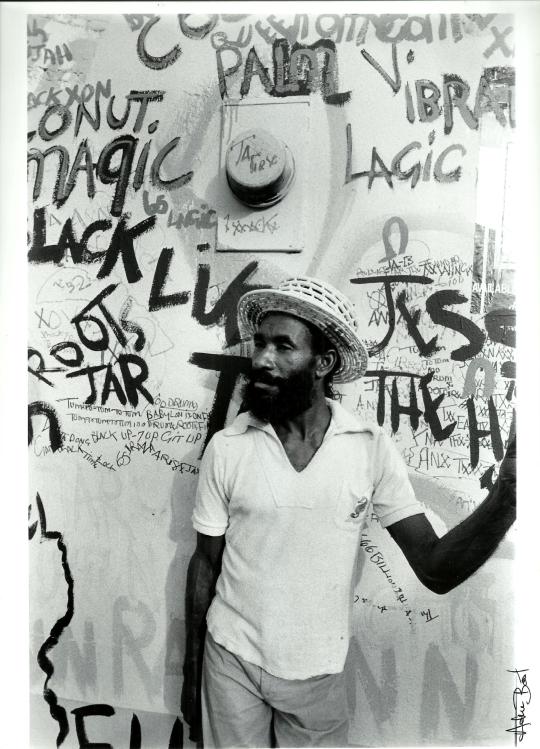
© Adrian Boot, circa 1977/ 1979. Part of JKD’s private photo collection.
This Baroque environment was part of the eccentric personality of the genius producer, embodied in an increasingly extravagant look and outfits over the ages: during his final years, he used to dye his hair and beard yellow, green of even pink, and he was decked out in completely fantastical clothes, personalised with pins and other fanciful objects. And when he was not wearing his famous golden baseball cap, adorned with glittering CDs, badges or religious illustrations, he was wearing a Native American feathered war bonnet or a wizard hat.

© Lee Scratch Perry painting in his studio in Switzerland (Blue Ark), 2018. Photo: Lorenzo Bernet. Courtesy: The Visual Estate of Lee Scratch Perry / suns.works.

© Lee Scratch Perry wearing his wizard hat in his studio in Switzerland (Blue Ark), 2019. Photo: Lorenzo Bernet. Courtesy: The Visual Estate of Lee Scratch Perry / suns.works.
It is more than clear Lee “Scratch” Perry was an artist with a capital A, a complete, total, full-time artist who did not switch to Rainford Hugh Perry (his real name) in private and who did not lock himself into a single box: the one of music. He did not play a role, he lived through his art full-time and was attracted as much to sounds as to visuals. Indeed, the latter played a significant role in his galaxy, in his symbolism, in his perception of the world. According to Perry himself, the image was the preferred channel for conveying messages (often subliminal), it was therefore necessary for him to be wary of them and to be able to reappropriate them. In some way, it can enable us to understand his involvement (conscious or unconscious) in the visual arts, which by the way was not recent. Indeed, reading his brilliant biography written by David Katz, we can easily realize that Perry had always been interested in his physical and cultural environment, the objects that surrounded him as well as the pop culture into which he loved to dig.
Even in the late 1950s, long before he began his musical career, when he worked in construction in Negril and drove bulldozers, Perry focused his attention on the noises associated with construction work and the energies of machines as they came into conflict with nature, one can read in People Funny Boy. He even reported an almost supernatural experience, resulting in his departure from this seaside resort located at the far western part of Jamaica to the capital Kingston in the early 1960s: “I get an overload from throwing stones down there for maybe two weeks. I started making positive connection with stones, by throwing stones to stones I start to hear sounds. When the stones clash I hear the thunder clash, and I hear lightening flash, and I hear words, and I don’t know where the words them coming from. These words send me to King-stone: to Kingston” (2000: 8).
Until the end of his life, stones occupied a pre-eminent place in his resolutely mystical universe. He regularly collected them, piled them up, carried them to various places, and even cooked them in a pot on the fire. In the late 1970s, that is precisely what happened, says Pauline Morrison, in their home in Washington Gardens, Kingston, which also housed his legendary recording studio.
“Pauline has claimed she was preparing a meal one afternoon when she noticed an odd smell coming from the kitchen. When she checked the pot, she found that Scratch had emptied the simmering contents into the mud of the yard, substituting a pan full of rocks in their place on the fire” (2000: 324). “If you see our house, this guy write all kind of shit on the wall, on the fence…” (2000: 323). And the Jamaican singer, Vicky Nelson, added, “my foot would be in paint, I would get rocks and all those nature things” (2000: 345).
As Pauline Morrison and Vicky Nelson suggest, Lee Perry also paid a great importance to writing and painting at the time of Black Ark. We must indeed go back very far in time to understand the links he developed with the visual arts and everything encompassed by this generic term: calligraphy, graffiti, assemblages, collages, installations, and painting among others. In short, everything that would make up his artistic inventory alongside his music. Lee “Scratch” Perry had always been a compulsive sketcher and graffiti artist, feeling a certain need to fill, if not to say overload, empty surfaces. From the end of the 1970s onwards, he even seemed to pay as much attention to the decoration of his studio as to musical production at times.
"Jean-Michel Basquiat himself called him a significant source of inspiration for his paintings"
Moreover, it is not surprising that at that time Lee Perry also commissioned art from Rastafarian artist Jah Wise to decorate the Black Ark. Indeed, he had the walls surrounding the studio decorated with huge, multicoloured murals painted by Robert Van Campbell aka Jah Wise. A portrait of Haile Selassie was placed just above the door so that all would have to ‘bow’ to Jah upon entering or leaving; to the left of his head was Selassie in his feline form as the Conquering Lion of Judah. Another wall had a life-size mural of the Super Ape, tree and spliff in hand, while the inside of the studio depicted African ancestors in chains and Rastafarian tri-colour flags. As time passed, such images would be altered and re-cast as Perry sought to express different concepts; like the music that was coming from inside the studio, its illustrated walls would seldom remain static. He also erected a sign with a ‘Management Order’ by the front gate, proclaiming that the premises included the site of a private house where women and children lived; all who sought to enter were to wait for official permission and once inside, were to refrain from using indecent language. (In People Funny Boy, French edition, 2012: 476-477).
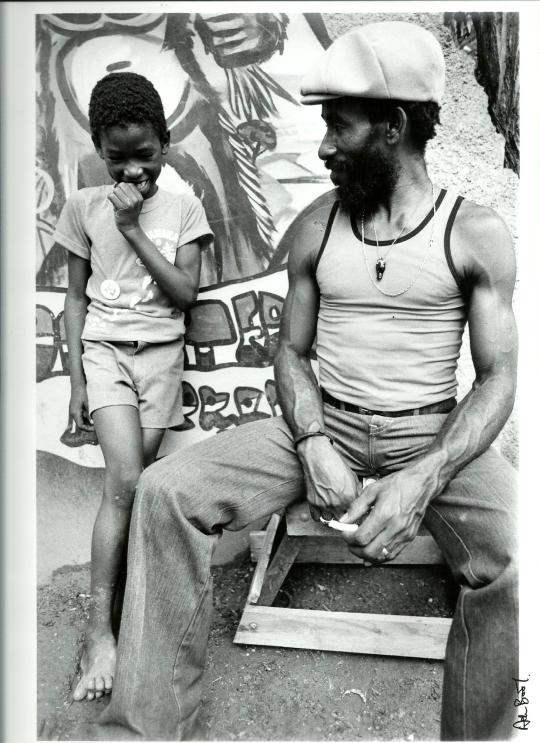
© Adrian Boot, 1978. Lee Perry and his son, Mark (aka Omar), at the Black Ark. In the background there is a glimpse of the “Super Ape” painting done by Jah Wise. Part of JKD’s private photo collection.
youtube
Lee “Scratch” Perry outside Black Ark Studios, Jamaica, 1977, premium footage from the Don Letts Archive available on YouTube.
All things considered, Lee Perry’s artistic source of creation originated far away back in time and widely developed during the seething cultural period of the Black Ark. Back in the 1970s, Lee Perry was already considering himself as a multi-disciplinary Artist and was already in contact with avant-garde people not only from Jamaica but also from England (Don Letts, John Lydon from the Sex Pistols, The Clash etc.).
After the Black Ark was destroyed by fire on one morning in the summer of 1983, Lee Perry experienced a very long period of exile, first in England, then in Switzerland where he moved out at the end of the 1980s with his new and last wife, a sultry queen of the Zurich nightlife, born Mireille Ruegg, only daughter of a couple of Swiss restaurateurs, who would become his manager. It was then that he started to show more and more interest in art, in a more professional way shall we say, the collections of four-handed paintings executed with British visual artist, Peter Harris, first between 2007 and 2009, then between 2014 and 2015, constituting a very good illustration of the extent of his pictorial work.
The Meeting with British Visual Artist Peter Harris
“How does a 40-year-old white British artist meet up with a 70-year-old black shaman from Jamaica and make a real connection? I am not a Rastafarian black man from the ghettos of Trench Town, I am a lower middle class Catholic son of an absent submariner father who moved from place to place and, as a consequence, has no ‘roots’ to speak of. This has led to a lifetime of what I suspect will be an unachievable search for home. I have lived through a series of popular culture ‘father figures’ who have been inspirational guides such as Bob Dylan, Francis Bacon, Johnny Rotten and Picasso, and Lee is one I’ve been lucky enough to meet in person. […] Lee’s experience and understanding - or “overstanding” - of Babylon is very different to my version of it. Lee’s version of Babylon might come from the Rasta’s view of western society as being corrupt, a world of ‘politricks’ and oppressors of Rastafarians. My version of Babylon is also about a society that oppresses our lives, but it is more about the unrelenting trajectory of existence. It might go something like this: birth, school, dreams, peer pressure, music, drugs for fun, student loans, love, jobs, depression, pressure, holidays, insecurity, mortgage, drugs for escaping, children, stress, peer pressure, cars, responsibilities, doubts, reality, panic attacks, bills, new clothes. In it but not of it, pets, vet bills, gym, mid-life crisis, new haircuts, hair loss, beer bellies, guilt, cigarettes, alcohol, food, cancer, medicine, pensions, fear, death” (interview conducted with Peter Harris by JKD, 2014).
In February 2005, Lee “Scratch” Perry responded positively to a request from Peter Harris who wanted him to be in a film he was working on, called Higher Powers. “I wanted different sorts of people who represented different kinds of higher powers,” Harris explains, “almost archetypal people. It might be a powerful gangster outside the law or a police chief, to someone with a spiritual higher power, or someone who totally doesn’t believe in higher powers. For the creative higher powers, or the visionary people, I thought of Ken Russell and Lee Perry” (2012: 898).
The concept was an appealing one for Perry, so permission was granted for Harris to film him at home on February 14th. The British visual artist interviewed him on various themes such as: destiny, faith, redemption, luck, love, doubt, etc. He then returned to London to edit the results. Subsequently, Peter Harris planned further filming sessions with Perry for the same film project. On October 1, 2007, Peter Harris' film, Higher Powers, was screened for the first time at the Lüneburg Art Hall in Germany. Perry appeared in the company of such controversial personalities as former gangster Dave Courtney, gay rights activist Peter Tatchell, Conservative politician Boris Johnson, Reverend Joanna Jepson (who has campaigned against the use of abortion for “eugenic reasons”), paranormal spoon-bender Uri Geller, Tibetan Buddhist monk Akong Tulku Rinpoche, and conspiracy theorist David Icke (2012: 910). Some years earlier, Harris had approached performers such as David Bowie, Siouxsie Sioux and members of the Stranglers, for ideas that he could turn into paintings; with a similar concept in mind, Harris returned to Switzerland in November 2007 to make a series of collaborative drawings with Lee Perry, ultimately inducting Perry into the world of fine arts.
“I’d done a Self-Portraits by Proxy series before,” Harris explains, “in which every person who had affected my life and influenced me, I asked for an idea, and then made that idea into a painting, but with Lee, it was a bit different. I called him up and said, ‘I’ve got these themes from the film, and I want you to give me the first image that comes into your head’; I’d say, ‘Luck,’ or whatever, and he would come up with some mad image, and I’d make it a drawing. Then I took all the drawings to his place in Switzerland, and he said we should cut them up; he was remixing them, like a record, taking something from one drawing and placing it with another, and it was more like a ceremony, or an Obeah ritual, so he spent a lot of time trying on different hats and costumes, as if he was getting into character. We started work at seven, and worked right through till four in the morning, and he had one CD that was just on repeat the whole time” (2012: 911).
On September 10th, Perry performed a special live dub set at London’s Tabernacle, with Adrian Sherwood at the mixing desk and live video animation behind him, as the climax of the “Higher Powers” art exhibition arranged by Peter Harris, which showcased the drawings the pair had produced in 2007, as well as a number of collaborative paintings they made together in Switzerland on August 15th 2009. The artwork dealt with typical Perry themes, such as social injustice, religious dogma, the unequal distribution of wealth, sex, and personal vengeance; some of the paintings bore the man’s handprints and footprints as well, while both paintings and drawings were marked by Perry’s declamatory graffiti (2012: 920). Images of the painting sessions carried out jointly by Peter Harris and Lee Perry in 2007 and 2009 as well as footages from the Tabernacle exhibition are viewable in the documentary, Lee Scratch Perry's Vision of Paradise, directed by Volker Schaner in 2015, an excellent film which also retraces the unusual trajectory of Lee Perry and clearly reflects the great part that art played in his daily life.
youtube
Lee Scratch Perry’s Vision of Paradise by Volker Schaner.
And as for the hundred works of art that the two artists made together between 2014 and 2015, they draw their inspiration from the Bible, from the Book of Revelation in particular.“With its tales of evil deeds, redemption and the apocalypse. It is rich in imagery, metaphor and parables. A parable is not a literal thing. It would not make sense to our modern minds, informed by readily available facts, to take it so. Language and visual language are vehicles for getting at some ‘truth’ as truth is often inexpressible” (interview conducted with Peter Harris by JKD, 2014).
This meeting with Peter Harris was clearly a step forward for Lee Perry into the world of contemporary art.

“Ja Pay” © Peter Harris and Lee “Scratch” Perry, biro pen and permanent marker pen on paper, 42 x 42 cm, 2007.
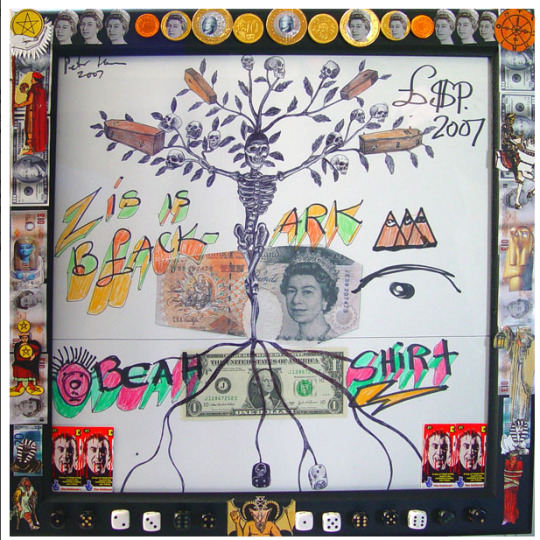
“Zis Is Black Ark” © Peter Harris and Lee “Scratch” Perry, collage, biro and pencil on paper, 42 x 42 cm, 2007.

“Judgement Com Yow” © Peter Harris and Lee “Scratch” Perry, marker pen, oil, acrylic paint on canvas, 123 x 109 cm, 2009.

“Super Ape” © Peter Harris and Lee “Scratch” Perry, biro pen, marker pen, felt tip and gold leaf paint on paper, 30 x 42 cm, 2014-2015.

“Super Man in Space” © Peter Harris and Lee “Scratch” Perry, biro pen, marker pen, felt tip and gold leaf paint on paper, 30 x 42 cm, 2014-2015.
The Rise of Lee Perry into the Contemporary Art World
A contemporary artist status confirmed by his induction into the Pantheon of sculptures made by Xavier Veilhan - using a 3D scanner - and held simultaneously in New York and Paris in the spring of 2015. During this double exhibition organised around music and simply named “Music”, the French visual artist wanted to pay tribute to the great music producers who had been shaping the soundtrack of our time, including Philippe Zdar, Pharrell Williams, Quincy Jones, Daft Punk, Rick Rubin, Brian Eno and Lee “Scratch” Perry. The latter therefore appeared in this impressive list of geniuses (around twenty in total), whose collectors are now snapping up statues made from a range of varied materials (from wood to metal through polyurethane resin).

“Lee Scratch Perry”, © Xavier Veilhan, “Music” exhibition, aluminium-filled polyurethane resin, plywood, acrylic paint, varnish, 122,5 x 62 x 86 cm, 2015.
What followed was a portrait (on paper this time) dedicated to him by the monthly art French magazine, Beaux-Arts, in 2017, on the occasion of the exhibition “Jamaica Jamaica!” held at the Paris Philharmonic (April 4-August 13, 2017), where the above-mentioned statue created by Xavier Veilhan was moreover exhibited.
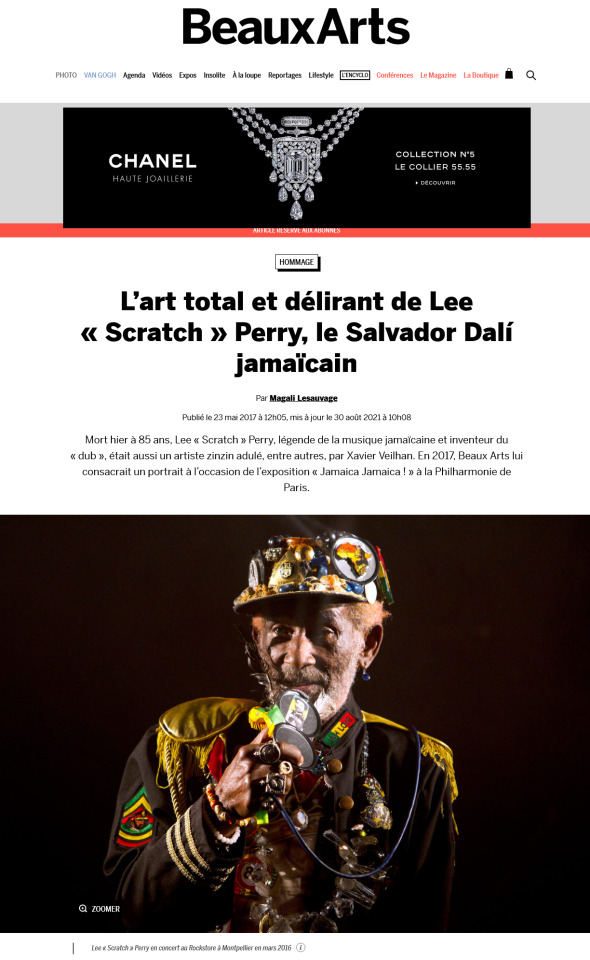
© article published on 23 May 2017 by Magali Lesauvage in Beaux-Arts.
Lee Perry made the front cover of other art magazines, such as the Italian biannual, Kaleidoscope, in 2020-2021.
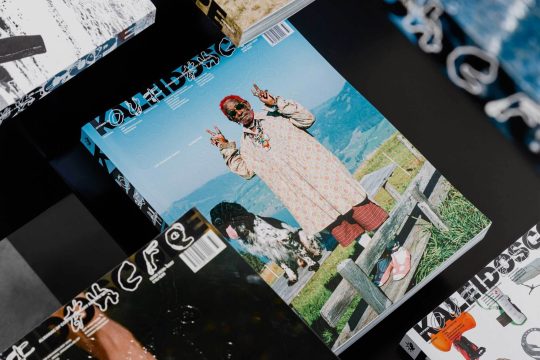
© Kaleidoscope, number 37, 2020-2021.
Finally, alongside all this, Lee Perry's visual artworks have been the subjects of numerous personal and group exhibitions around the world, starting with his very first solo exhibition held at the Californian gallery Dem Passwords from November 13 to December 11, 2010 under the name “Secret Education”.

© Dem Passwords, « Secret Education » exhibition, 2010.
Three other solo exhibitions were organised by this same gallery in 2013 (“Repent Americans” from April 20 to June 15), 2014 (“The Death of Baphomet” from August 29 to October 11) and 2016 (“Judgment Repentance God Order” from June 16 to July 30).
"these many art exhibitions around the world have coincided with the new curatorial team responsible for the visual estate of Lee “Scratch” Perry and headed by Lorenzo Bernet (...) this new, fresh and dynamic curatorial team seems to come up with creative and innovative ideas"
In that same year, Lee Perry also did an art show in New York, from June 29 to July 29, 2016 as part of a collective exhibition entitled “A Being in the World” and held at Salon 94 on the lower east side of Manhattan. His pieces of work were thus exhibited alongside those of a very heterogeneous panel of artists, including the African-American self-taught artist and former slave, Bill Traylor (1854-1949), and Maia Ruth Lee (born in 1983 in South Korea).

© Dem Passwords, « Judgement Repentance God Order » exhibition, 2016.
Then, Lee Perry multiplied international shows: at the Swiss Institute in New York in 2019, at the 2021 São Paulo Bienal, at the Museum of Contemporary Art of Rome in 2022, and at the Cabinet Gallery in London as well as at the 2023 Art Cologne international art fair, just to name a few. In total, Lee Perry actively took part in no less than fifteen international exhibitions between 2016 and 2023, and almost half of them in the last couple of years, which is the guarantee of a rocket-like rise on the contemporary art scene. Regarding this latter point, it is crucial to emphasize that these many art exhibitions around the world have coincided with the new curatorial team responsible for the visual estate of Lee “Scratch” Perry and headed by Lorenzo Bernet, a Zurich-based gallerist, curator and art dealer who is also the man behind the suns.works gallery. Therefore, it might be no exaggeration to say that this art world rocket rise relates to this new, fresh and dynamic curatorial team that seems to come up with creative and innovative ideas.

“Flood Sun” © Lee Scratch Perry, collage, markers and acrylic on wooden board, 60 x 100 cm, 2020. Courtesy: The Visual Estate of Lee Scratch Perry / suns.works.
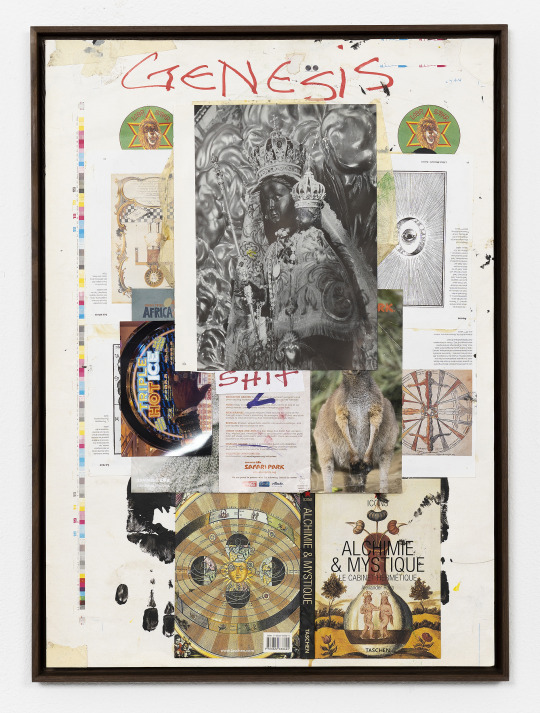
“Genesis” © Lee Scratch Perry, collage and acrylic on paper, 70 x 50 cm, 2020. Courtesy: The Visual Estate of Lee Scratch Perry / suns.works.

“Pisces and Aries (Yin Yang)” © Lee Scratch Perry, collage and acrylic on canvas, 170 x 140 cm, 2020. Courtesy: The Visual Estate of Lee Scratch Perry / suns.works.
It is also important to underline the presence of some of his drawings, paintings, collages and other installations in the collections of art aficionados like Sir Raymond Douglas Davies aka Ray Davies (former songwriter and lead vocalist for the legendary British rock band the Kinks), English record producer Adrian Sherwood (Coldcut, Depeche Mode, Primal Scream, Sinéad O'Connor, Lee “Scratch” Perry, Dennis Bovell), Mexican producer, remixer and composer Camilo Lara, and the British artist couple formed by Tim Noble and Sue Webster, as well as prestigious institutions such as the Bonnefanten Museum in Maastricht (NL). Others should soon be included in the permanent collections of the National Gallery of Jamaica as well as the Smithsonian Institution in Washington which currently investigates, along with the National Museum of African American History and Culture, Afrofuturist expression through art, music, and activism among others: an exhibition (March 23, 2023 – August 18, 2024) in which Lee “Scratch” Perry appears next to avant-garde jazz legend Sun Ra and the leader of African American Funkadelic style George Clinton - the threesome being tied to raw, original and pioneering Black aesthetic forms. And again, one owes this real tour de force to the new curatorial team headed by Lorenzo Bernet!
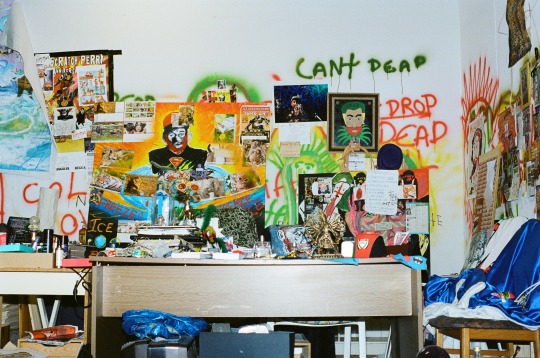
“Blue Ark (studio view)” © Lee Scratch Perry, 2016-2021. Photo: Camille Spiller. Courtesy: The Visual Estate of Lee Scratch Perry / suns.works.
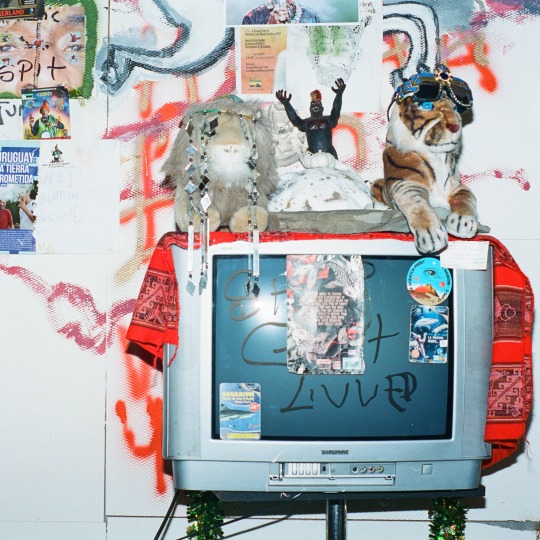
“Blue Ark with TV Sculpture (studio view)” © Lee Scratch Perry, 2016-2021. Photo: Camille Spiller. Courtesy: The Visual Estate of Lee Scratch Perry / suns.works.

“Blue Ark (studio view)” © Lee Scratch Perry, 2016-2021. Photo: Claude Barrault. Courtesy: The Visual Estate of Lee Scratch Perry / suns.works.
Last but not least, the resale of some of his artworks at auctions needs to be mentioned too, let alone the fact that Jean-Michel Basquiat himself called him a significant source of inspiration for his paintings, according to multi-disciplinary artist Lee Jaffe as well as the Gagosian Quarterly (Winter 2021 Issue).
A whole set of signals which suggests a more than bright future for Lee “Scratch” Perry in the modern and contemporary art world.

“Vanity Struck Me in My Tooth”, © Lee Jaffe in collaboration with Jean-Michel Basquiat, acrylic on Cibachrome print, 203 x 122 cm, 1983.

“Avenge” © Peter Harris and Lee “Scratch” Perry, marker pen, oil, acrylic paint on canvas, 124 x 95 cm, 2009. This work of art has been bought by Adrian Sherwood; it can be seen in the video below shot in 2022 in the deck-out living room of the producer.
youtube
Horace Andy : Tiny Desk (Home) Concert.
Books :
People Funny Boy: The Genius of Lee “Scratch” Perry, David Katz, 2000, Canongate Books, 538 pages.
Lee “Scratch” Perry: People Funny Boy, David Katz, 2012, Camion Blanc, 990 pages (French edition).
People Funny Boy: The Genius of Lee “Scratch” Perry, David Katz, 2021, Orion Publishing Group Limited, 688 pages (revised and expanded English edition).
Lee Scratch Perry: Black Ark, Andreas Koller & Lorenzo Bernet (Ed.), publication expected in July 2024, Edition Patrick Fey, 600 pages (500 illustrations).
Films :
Lee Scratch Perry’s Vision of Paradise, Volker Schaner, 2015, 100 min.
This article is the English, revised and expanded version of my paper published on Reggae.fr on 30 November 2023. © Jérémie Kroubo Dagnini (JKD).
#lee scratch perry#contemporary art#adrian sherwood#par reggae.fr#reggae#art#Youtube#art museum#collage art#installation art#jamaica#ray davies#the kinks#gagosian#basquiat#afrofuturism#afrofuturistic#artwork#drawings#installation#outside art#smithsonian#salvador dali#sun ra arkestra#george clinton
7 notes
·
View notes
Text
SUBSCRIBE
ENTERTAINMENT
IT’S LIT: Celebrating Travis Scott’s 33rd Birthday With All Of His Top 10 Billboard 100 Hits
Written byDavonta Herring
Published onApril 30, 2024
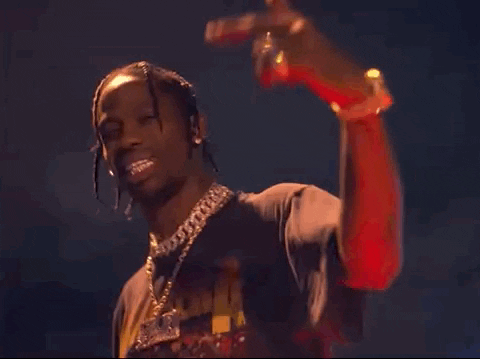
Source: Christopher Polk / Getty
One of the biggest artists and popular culture figures of this generation turned 33 today. Click inside to celebrate his legacy with a gallery of all of his Top 10 hits!
Jacques Bermon Webster II was born in Houston, Texas. Webster lived with his grandmother in South Park, Houston from ages one through six. He then moved to Missouri City to live with his parents. Due to the fact that Webster’s father is a soul musician and his grandfather was a jazz composer, music was already embedded in him. While attending Elkins High School, which he graduated from at 17, he participated in musical theater. During his second year at the University of Texas at San Antonio, Webster dropped out to fully pursue his music career.
One he left college, Scott moved to New York City. He slept on his friend’s floor and spent most of his time at Just Blaze’s studio. Unfortunately for him, progress didn’t come fast enough. He moved to Los Angeles after only living in NYC for four months. After falling on tough times in LA, Scott moved back to Houston but was eventually kicked out of his parent’s home. When he moved back to Los Angeles, he began to sleep on the couch of a friend who studied at University of Southern California. Around the time, Grand Hustle Records rapper and owner T.I. heard one of Scott’s productions. One of T.I.’s representatives invited Scott to a studio for a meeting. During the meeting, T.I. rapped over one of Scott’s productions, laying the groundwork for Scott to sign with Grand Hustle.
After several delays, Scott’s first solo full-length project, Owl Pharoah was released on May 21st, 2013. The following year, he released Days Before Rodeo, his second mixtape and the prelude to his debut studio album Rodeo. The highly-anticipated album was released on September 4th, 2015. It debuted at number three on the US Billboard 200 chart and catapulted him to a household name. Since then, Travis has released three more solo albums (Birds in the Trap Sing McKnight, Astroworld, Utopia) with all three reaching number one of the US Billboard 200, a collaborative album (Huncho Jack, Jack Huncho) with Quavo and a compilation album (Jackboys) with the rappers signed to Scott’s Cactus Jack imprint.
Cactus Jack Records, which was founded in 2017, is just another venture Travis has dived into. He started the annual music festival Astroworld in 2018. Over the years, Scott has collaborated with countless clothing and sneaker brands including Been Trill, Diamond Supply Co., A Bathing Ape, Nike, Helmut Lang and Jordan, just to name a few. The ‘Pick Up The Phone’ artist has teamed up with the likes of Fortnite, McDonald’s and even PlayStation to promote special merchandise, meals and so many other things. He made his theatrical in the 2021 film Gully. Later in the year, he signed a movie production deal with A24.
Travis Scott has left an undeniable mark on this generation. Although he is involved in so many things, the world initially came to love him based on his music prowess. To celebrate his legacy and his birthday, check out our gallery of all of his Top 10 Billboard Hot 100 hits. HAPPY 33RD TRAVIS!
1. Drake ft. Quavo & Travis Scott – Portland
Source:Drake
2. Stargazing
Source:Travis Scott
3. Sicko Mode ft. Drake
Source:Travis Scott
4. Lil Wayne ft. Travis Scott – Let It Fly
Source:Lil Wayne
5. Kodak Black ft. Travis Scott & Offset – ZEZE
Source:Kodak Black
6. Post Malone ft. Ozzy Osbourne & Travis Scott – Take What You Want
Source:Post Malone
7. Highest In The Room
Source:Travis Scott
8. Travis Scott & Kid Cudi – The Scotts
Source:Travis Scott
9. Franchise ft. Young Thug & M.I.A.
Source:Travis Scott
10. Drake ft. Travis Scott – Fair Trade
Source:Drake
11. Drake ft. Travis Scott – Pussy & Millions
Source:Drake
12. Travis Scott, Bad Bunny, The Weeknd – K-POP
Source:Travis Scott
13. Travis Scott ft. Drake – MELTDOWN
Source:Travis Scott
14. Travis Scott ft. Playboi Carti – FE!N
Source:Travis Scott
15. 21 Savage, Travis Scott, Metro Boomin – née-nah
Source:21 Savage
16. Future, Metro Boomin, Travis Scott, Playboi Carti – Type Shit
Source:Future
17. Future, Metro Boomin, Travis Scott – Cinderella
Source:Future
RELATED TAGS
Sent from my iPhone
6 notes
·
View notes
Text
Dr. Stacy Alaimo
(she/they)
Professor of English, Director of Graduate Studies for English;
Core Faculty Member, Environmental Studies;
COLT Participating Faculty; CSWS Faculty Affiliate
University of Oregon
I write about the strange and often volatile relations between environmentalism, science, theory, literature, art, popular culture, and gender. My concept of trans-corporeality links material feminism, new materialism, environmental justice, and environmental posthumanism. While my first three books build one coherent theoretical argument, my recent work turns to ocean life, developing the "blue" or oceanic humanities along with marine science studies.
Current Project:
The Abyss at Hand: Aesthetic Encounters in the Science, Art, and Literature of Deep Sea Creatures.
This book investigates the science, art, film, science fiction, and science writing about deep sea creatures, from the work of William Beebe and Else Bostelmann in the 1930s to the Census of Marine Life, which concluded in 2010. It investigates how aesthetic recognition of deep sea creatures scrambles scientific epistemologies and expands the terrain of environmental concern. I grapple with colonialist global visions, critique white masculinist narratives of exploration, analyze the categories of the surreal, weird, and alien; and swirl together emerging theories and methods in the blue humanities, while suggesting a more fluid and potent sense of the aesthetic. As the threats to ocean ecologies accelerate and the deep seas receive scientific, popular, and political attention, I hope this book will incite more discussion of the abyss at hand.
Exposed: Environmental Politics and Pleasures in Posthuman Times (Minnesota 2016) contends that the anthropocene is no time to set things straight. The book resists the temptation to engage in any sort of grand mapping that would be inimical to the embedded modes of epistemological, ethical, and political engagement that it traces, working instead through a surprising mix of theory, science, art, and activism. It begins by considering the pleasures of inhabiting places where the domestic refuses to domesticate and the walls decline to divide. It ends with an imaginary inhabitation of the dissolving shells of sea creatures who epitomize extinction in anthropocene seas. Along the way it considers queer animals, naked protests, the strange agencies of plastic pollution, and the gendered politics of climate change. Dwelling in the dissolve, where fundamental boundaries have begun to come undone, unraveled by unknown futures, can be a mode of ethical engagement and political inhabitation, which emanates from both feminist and environmentalist practices. Exposed locates new materialisms and material feminisms in fleeting ethical moments and compromised political sites that make up the massive temporal and geographical expanse of the anthropocene.[Cover art: Marina Zurkow, video still from "Slurb."]
Italian translation, published by Mimesis, 2023.
Korean translation, translated by Myung-Joo Kim, Chungnam National University Press, 2023.
Chapter,“Eluding Capture: The Science, Culture and Pleasure of “Queer” Animals,” translated into Greek by John Giannis/Rigas Ioannis, for a DIY activist zine, with new illustrations, 2017.
Inspired special issue of Simulacrum magazine (Amsterdam) “Practicing Exposure.” Including an interview with Max Litjens and Michelle Geraerts, 2019. http://simulacrum.nl/2019/call-for-papers-practicing-exposure-simulacrum-x-fiber-festival/
Special session, “Author Meets Readers” at the Association of American Geographers, 2018.
Podcast Interview, with Chris Richardson, This is Not a Pipe, February. 2018.https://www.tinapp.org/episodes/exposed
U of MN: Blog post: “Climate Change, Carbon-Heavy Masculinity and the Politics of Exposure” http://www.uminnpressblog.com/2016/10/climate-change-carbon-heavy-masculinity.html (October, 2016)
Culture of Energy Podcast, #39, with Cymene Howe and Dominic Boyer, Center for Energy & Environmental Research in the Human Sciences, Rice University
Podcast interview: New Books in Environmental Studies, New Books Network: Feb., 2017.
Finalist for 2017 ASLE Book Award for Ecocriticism
Bodily Natures: Science, Environment, and the Material Self (Indiana UP, 2010). Environmental justice, environmental health, and material feminisms occupy the "trans-corporeal" sites where body, place, and substance intersect. Bodily Natures develops my new materialist, material feminist conception of environmental thought and practice. [Cover art: "Toxic Girl," Fawazo.]
Winner of the ASLE Book Award for Ecocriticism, 2011
Featured in New Books Network interview and podcast, 2013: http://newbooksnetwork.com/stacy-alaimo-bodily-natures-science-environment-and-the-material-self-indiana-up-2010/
Plenary book session at the International Association of Environmental Philosophy, Eugene, Oregon, 2013.
Korean translation,by Joon Yun, Konkuk University, Seoul, Institute of Body and Culture, published by Greenbee, as 말, 살, 흙, Word, Flesh, Dirt, 2018; second printing, 2018.
Chapters translated into Portuguese, Spanish, Polish,
Key concept, “trans-corporeality” taken up widely in humanities and social sciences, and included as an entry in Rosi Braidotti’s The Posthuman Glossary
Art exhibit, “Transcorporeality” at the Museum Ludwig, Cologne Germany, Fall 2019; published essay in catalogue, Fall 2020.
Undomesticated Ground: Recasting Nature as Feminist Space (Cornell 2000) Written during a time when academic theory spurned the concept of "nature," this book delves into the negative discursive histories of that term, while posing more positive visions for feminist environmentalisms. By drawing on poststructuralist feminist theory and cultural studies, I advocate gender-minimizing, queer, intersectional feminisms that recast nature as feminist space. Darwinian feminists, Marxist feminists, birth control activists, postmodern artists and novelists, and queer writers reinvent the concept of "nature," contending that culture, not "nature" is the ground of essentialism and gender normatively. [Cover art: Ana Mendieta.]
Excerpts on “Mother Earth” reprinted in Nuda Paper(commercial paper sold in Stockholm, Paris, Berlin, and London), Fall 2019.
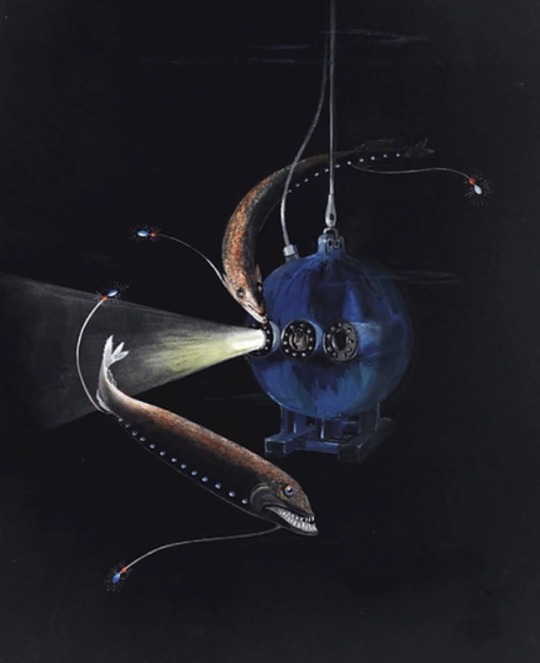
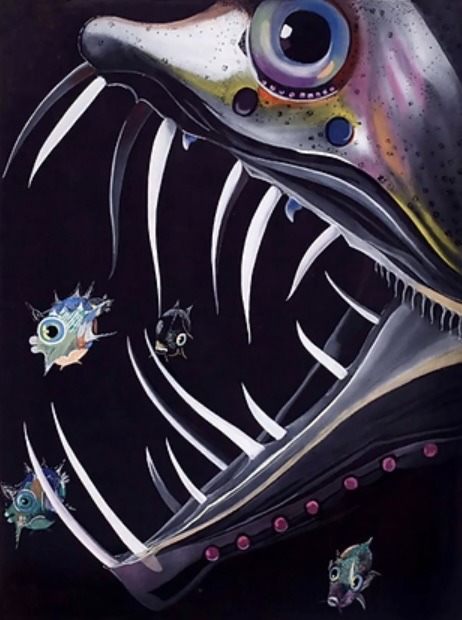

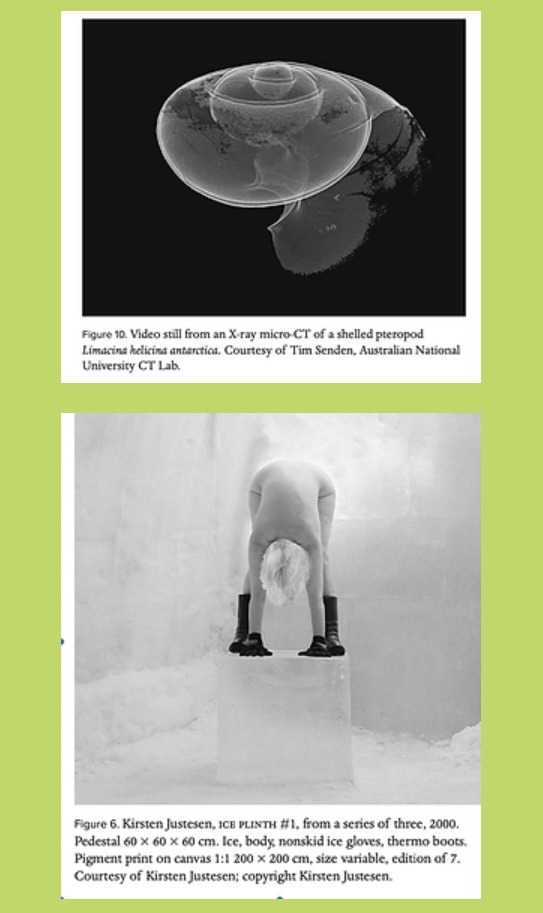

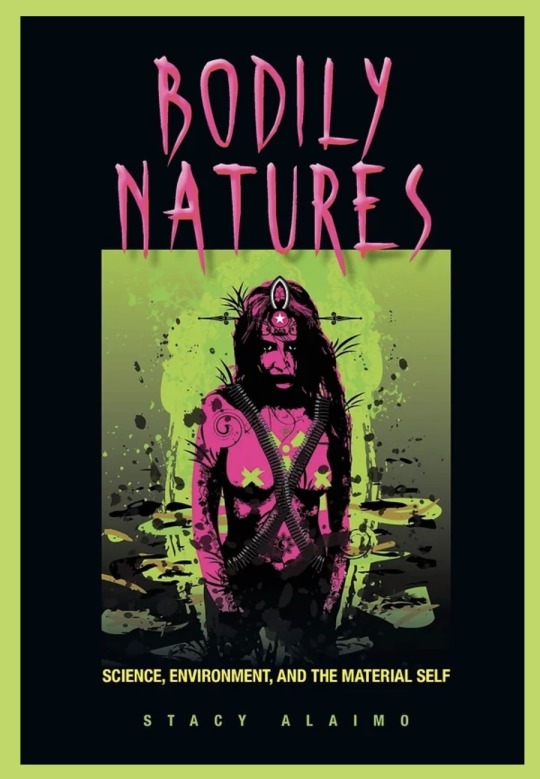
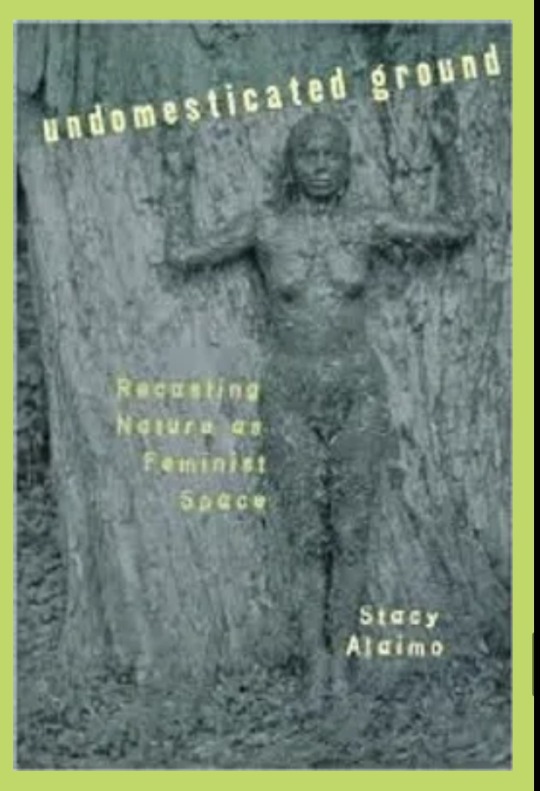

#Stacy Alaimo#post-humanism#ocean ecologies#art and ecology#ecology#science and art#queer animals#climate change#gendered politics#anthropocene
3 notes
·
View notes
Text
Deltarune Will Be Available For Purchase When Chapter 4 Is Done, Chapter 5 To Arrive Later
New Post has been published on https://thedigitalinsider.com/deltarune-will-be-available-for-purchase-when-chapter-4-is-done-chapter-5-to-arrive-later/
Deltarune Will Be Available For Purchase When Chapter 4 Is Done, Chapter 5 To Arrive Later


Developer Toby Fox followed up their 2015 critically acclaimed and fan-favorite 2D RPG Undertale with Deltarune Chapter 1 in 2018. This chapter was the first in what we’d later learn is a five-chapter top-down RPG with puzzles, bullet hell sequences, and Final Fantasy-inspired combat, and Chapter 1 was released for free. Fox dropped Chapter 2 in 2021 in a surprise announcement, and now, players patiently await the release of Chapter 3. Today, more than two years later, Fox has revealed an updated plan for their Deltarune release strategy.
[embedded content]
With Chapter 3 nearing completion, Fox plans to finish Chapter 4 and release Deltarune as a purchaseable product. And following that, development on Chapter 5 will continue and hit the game when it’s ready. To help with this, Fox has hired a producer “whose entire job it will be to speed up the overall game development for future chapters,” according to a new statement released.
You can read Fox’s full statement below:
“So, now that Chapter 3 is nearing completion…I think it’s a good time to re-discuss how we will release Deltarune for purchase. My original plan was to release Chapter 3, 4, and 5 together. However, the finish line of Chapter 5 is still pretty far off…and I don’t think anybody really wants to wait that long to release anything. Especially me.
So, new strategy: No more waiting for Chapter 5. Instead, we are going to focus on putting Deltarune out for purchase once we finish Chapter 4. That should make everything a bit more reasonable! Chapter 4 already has a very substantial amount of cutscenes and enemy work done. Also, I’ve hired a new producer whose entire job it will be to speed up the overall game development for future chapters. So, I feel very optimistic about the next steps of this project.
That being said though, I think I’m going to pause on more detailed development updates for now. Instead, I’ll just let you guys know if the development is getting close to completion, or if something funny happens.”
Elsewhere in the update, Fox says Chapter 3 took a lot of trial and error to figure out how it would work but that with Chapter 4, “I already feel very confident about how we can progress.” They also note that people on the team are already transitioning back into working on Chapter 4 and that everybody is excited to work on that part of Deltarune.
For more about the game, watch the original Deltarune teaser and then check out this Chapter 2 teaser. After that, read Game Informer’s Undertale review.
Are you going to purchase Deltarune with the release of Chapter 4? Let us know in the comments below!
#Developer#development#Full#Funny#Future#game#game development#hired#how#it#Learn#plan#project#Puzzles#Read#review#speed#strategy#time#work
2 notes
·
View notes
Text
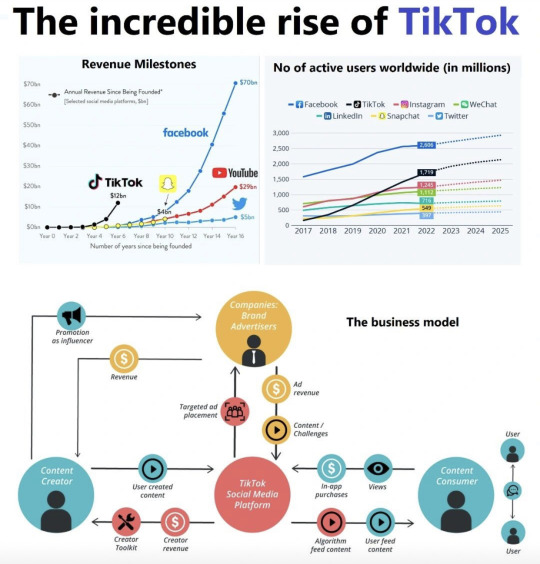
"Unveiling the Unstoppable Surge of TikTok: How This Global Phenomenon is Revolutionizing Social Media, Commerce, and Beyond!"
Diving Deep into TikTok's Unstoppable Revolution: Witnessing the Phenomenon That's Reshaping Social Media, Commerce, and More - A Must-Read Journey! TikTok's meteoric rise is not only reshaping the landscape of social media, but it's also ushering in profound cross-industry effects that extend into e-commerce, digital advertising, and payments, among other areas. Let's delve into this transformative phenomenon.
Initially introduced as Douyin by ByteDance in 2016, TikTok made its global debut in 2018 and has since established a presence in 154 countries, reaching a remarkable milestone of 1 billion users faster than any other social platform.
At its core, TikTok's success is rooted in simplicity: a video-sharing app that empowers users to effortlessly create and share short videos. Its standout feature, however, lies in its algorithmic prowess, which rapidly curates videos from its expansive database based on user preferences. Unlike conventional platforms, TikTok doesn't rely on established networks for virality, allowing anyone to achieve global recognition without an extensive follower count.
Statistics underscore TikTok's influence, with users dedicating an average of over 1.5 hours to the platform, primarily comprising Generation Z (individuals born between the late 1990s and early 2000s). In the #US, TikTok has become the premier video destination, outshining its social media counterparts. The emulation of TikTok's model by industry giants such as #Meta, #YouTube, #Pinterest, and Netflix is a testament to its disruptive impact.
Expanding beyond its humorous video content, TikTok is instigating paradigm shifts in various sectors. Notably, within digital advertising, projections indicate a substantial leap in TikTok's ad revenues, soaring from $13 billion in 2022 to $44 billion by 2027. Concurrently, TikTok Douyin's revenue in China is predicted to rise from $28 billion to $76 billion. By 2027, global online video advertising is set to generate over $331 billion, with TikTok commanding 37% of these earnings, equivalent to $120 billion. In comparison, the combined presence of YouTube and Meta is estimated at 24% or $77 billion.
On the e-commerce frontier, TikTok's foray into live shops embedded within user profiles (deployed in regions like the #UK, Southeast #Asia, and the US) enables in-app purchases, potentially paving the way for live-stream shopping to become a pivotal e-commerce trend. In #China, TikTok's direct in-app sales are substantially challenging established e-commerce titans like JD and Alibaba. Douyin's strategic focus on "interest e-commerce," driven by users' passions, signifies a multidimensional approach to consumer engagement encompassing short videos, livestreams, and searches.
This seismic shift reminds us that the world is evolving rapidly, surpassing some in its velocity of change.
Join me in uncovering the seismic shifts powered by socialmedia- from reshaping social landscapes to igniting a commerce evolution. Let’s ride this wave of transformation together! Don’t miss out – hit that follow button for more captivating insights. 🚀🔥
#TikTokRevolution #StayInformed #TikTokTransforms #SocialShiftsUnveiled #CommerceEvolution #TrendingTikTok #InnovationUnleashed #rtumovs #tumovs
2 notes
·
View notes
Text
yes, queers, assimilate into the forms considered acceptable to cisheteronormativity, shh, now, don't reject it, transmedicalism is good, just conform

We’ve endured the criminalization and crucifixion of our bodies, our sex, our unruly genders. Raids, witch-hunts, burnings at the stake. We’ve occupied the space of deviants, of whores, of perverts, and abominations. This culture has rendered us criminal, and of course, in turn, we’ve committed our lives to crime. In the criminalization of our pleasures, we’ve found the pleasure to be had in crime! In being outlawed for who we are, we’ve discovered that we are indeed fucking outlaws! Many blame queers for the decline of this society—we take pride in this. Some believe that we intend to shred-to-bits this civilization and it’s moral fabric—they couldn’t be more accurate. We’re often described as depraved, decadent and revolting—but oh, they ain’t seen nothing yet.
"A Gang of Criminal Queers," Total Destroy, 2009
This negative queerness severs us from any simple understanding of ourselves. More so, it severs us from any formulaic or easily-represented notions of what we need, what we desire, or what is to be done. Our queerness does not imagine a coherent self, and thus cannot agitate for any selves to find their place within civilization. The only queerness that queer sexuality could ever hope to achieve would exist in a total refusal of attempts at the symbolic integration of our sexuality into governing and market structures. This refusal of representation forecloses on any hope that we ever have in identity politics or positive identity projects. We decline the progressive faith in the ability for our bodies to be figured into the symbolic order. We decline the liberal assurance that everything will turn out right, if we just have faith.
Baedan: Journal of Queer Nihilism
My queerness is an experimentation that never ends. It is the totality of a life lived against the law, insubordinate and wild. It is not a communist politics but a nihilist negation to all systems that attempt to subordinate individuality. It is not the leftist politics of demanding and building a better world but an anarchist insurgency of reclaiming life day to day, and setting fire to its captors. Since gender is embedded in every fabric of this industrial, civilized society, I find no hope in salvaging any part of it—only joy in every second of its calculated demise. Society and those who wish to preserve it require identity politics to categorize people based on socially assigned constructs. Identity politics is where individual experimentation goes to die. Like studying the bricks in a wall rather than venturing beyond the wall itself, identity politics, like all politics promotes the death of imaginative exploration. Politics represent the fixed ideological prescriptions of living, assigned to “the masses” who are treated as if they are incapable of thinking and acting as individuals.
Flower Bomb, Towards the Queerest Attack, 2018
I'm sorry, but I'm just too fucking old to pretend that the presidential ticket of "Person who performed some of the first gay marriages in her state while it was still federally illegal" and "governor who created a trans refuge state while other states were making it illegal to transition" is somehow 'jUsT aS bAd foR QuEer pEopLe' as the ticket promising to reverse marriage equality and make trans healthcare next to impossible.
That is such a monumentally stupid opinion that I'm going to have a hard time believing that you're actually that stupid, and I'll probably just assume you're malicious.
28K notes
·
View notes
Text
Fintech Market Forecast (2025–2030)
Fintech Market was valued at USD 352 billion and is projected to reach a market size of USD 1.02 trillion by the end of 2030. Over the forecast period of 2025–2030, the market is projected to grow at a CAGR of 23.52%.
Fintech (Financial Technology) represents the rapidly evolving intersection of financial services and technology that has fundamentally transformed how individuals and businesses manage their financial activities in the 21st century. With the accelerating digitization of financial services, the demand for innovative financial solutions is continuously rising. It is anticipated to create significant career opportunities over the next decade across the technology and financial sectors. On the business and investment side, fintech has attracted significant venture capital and private equity interest over the past decade. Startups in payments, buy-now-pay-later (BNPL), and embedded finance have scaled quickly, forcing legacy financial institutions to adapt or partner with fintech firms. Technologies like AI, machine learning, blockchain, and cloud computing have become central to fintech innovation, enabling personalized financial services, fraud detection, and decentralized finance (DeFi) systems. Therefore, it becomes imperative for industry leaders to develop new competencies and achieve a comprehensive understanding of all factors influencing fintech adoption while maintaining a strategic perspective.
👉 𝐃𝐨𝐰𝐧𝐥𝐨𝐚𝐝 𝐒𝐚𝐦𝐩𝐥𝐞
Key Market Insights:
According to a report published by the World Economic Forum in 2022, approximately 64% of consumers worldwide have utilized at least one fintech platform, with adoption rates increasing annually by nearly 15%. This growing user base for financial technology services is propelling the expansion of the global fintech market. Certain regions show significantly higher adoption rates due to favorable regulatory environments.
A survey by Statista indicates that Singapore has achieved 67% fintech adoption among its population, with neighboring Southeast Asian countries contributing substantially to regional growth. Consequently, rapid expansion in user volume is anticipated in the immediate future.
In China, mobile payment transactions reached $49.7 trillion in 2023, compared to just $1.4 trillion in the US. Digital wallet usage in India increased by 163% between 2020 and 2023, according to the Reserve Bank of India’s data, transforming financial inclusion in the region.
Peer-to-peer lending platforms typically charge 7–12% interest rates compared to traditional banks’ 15–25% for similar unsecured loans. As a result, lending platforms have seen transaction volumes increase by 43% year-over-year, with over 96 million users globally selecting alternative lending services for more favorable rates and convenience.
👉 𝐁𝐮𝐲 𝐍𝐨𝐰
Fintech Market Drivers:
The increasing smartphone penetration and internet accessibility worldwide are fundamentally transforming financial services accessibility and utilization patterns, creating unprecedented opportunities for fintech adoption.
The proliferation of smartphones, coupled with expanding internet coverage and decreasing data costs, has created fertile ground for fintech innovation and adoption across previously underserved markets. In emerging economies, mobile phone penetration has reached over 85%, with smartphones accounting for approximately 63% of these devices according to the GSMA Mobile Economy Report. This technological penetration has enabled financial services to reach previously unbanked populations, with an estimated 1.7 billion adults globally gaining access to formal financial services for the first time through mobile-based solutions. Mobile banking applications have seen a 72% increase in usage since 2019, with the average consumer accessing their financial applications 36 times monthly. Additionally, the decreasing cost of data (down 47% globally since 2018) has made continuous connectivity feasible for lower-income segments, expanding the potential user base. Cloud computing advances have reduced infrastructure costs for fintech startups by approximately 60%, allowing for greater innovation and competitive service offerings. Furthermore, the integration of biometric authentication has enhanced security perceptions, with 78% of consumers reporting greater confidence in mobile financial services featuring biometric verification, driving higher engagement rates.
Evolving consumer expectations and demand for seamless financial experiences are dramatically reshaping the financial services landscape and accelerating fintech adoption.
Modern consumers, particularly Millennials and Generation Z, who collectively will represent 72% of the digital consumer landscape by 2025, demonstrate markedly different financial behavior patterns compared to previous generations. Research indicates that 68% of younger consumers prioritize convenience and user experience over brand loyalty when selecting financial services providers. This demographic expects instant gratification, with 84% abandoning financial applications that require more than three steps to complete transactions. The demand for 24/7 service availability has reshaped service delivery models, with 92% of consumers expecting financial services to be accessible at any time and from any location. Additionally, the preference for personalization is driving the adoption of AI-powered financial management tools, with 76% of users reporting higher satisfaction with services that offer customized insights and recommendations. These shifting expectations have created significant opportunities for fintech companies that can deliver streamlined, intuitive, and personalized user experiences, often outperforming traditional financial institutions that struggle with legacy systems and processes.
Fintech Market Restraints and Challenges:
Because of its nature, there is no existing framework of regulations that poses barriers to business.
Regulatory complexity presents significant barriers to fintech market expansion, with companies navigating an intricate maze of jurisdiction-specific requirements that frequently evolve. In an industry survey, 68% of fintech executives identified regulatory compliance as their most significant operational challenge, with companies spending an average of 15% of operational budgets on compliance activities. Cross-border operations face particularly complex hurdles, with companies requiring an average of 18 months to expand internationally due to varying regulatory frameworks. Data protection regulations like GDPR and CCPA create additional compliance burdens, with penalties reaching up to 4% of annual global turnover for violations. Meanwhile, cybersecurity threats continue to escalate, with financial services experiencing a 238% increase in attacks.
👉 Enquire Before Buying
Fintech Market Opportunities:
The increasing focus on financial inclusion represents a substantial growth opportunity for fintech companies worldwide. With approximately 1.7 billion adults remaining unbanked globally, according to World Bank data, technology-driven financial solutions can bridge critical access gaps. Mobile money services have demonstrated remarkable success, with transaction values growing by 23% annually since 2018. Blockchain and distributed ledger technologies enable cross-border remittances at 70% lower costs than traditional methods, addressing a $540 billion market with substantial inefficiencies. Additionally, embedded finance — the integration of financial services into non-financial platforms — is projected to generate $230 billion in revenue by 2025, up from $43 billion in 2021.
Fintech Market Segmentation:
Market Segmentation: By Service Type:
• Digital Payments • Lending • Wealth Management • InsurTech • RegTech • Others
The digital payments segment dominated the global fintech market, accounting for approximately 32.4% of the market share by revenue. The proliferation of mobile payment applications, contactless payments, and digital wallets has driven substantial transaction volume growth, with global digital payment values reaching $8.3 trillion in 2022. This growth is particularly pronounced in emerging markets, where mobile payment adoption often leapfrogs traditional banking infrastructure, creating unprecedented financial access. In Southeast Asia alone, digital payment transaction values increased by 52% between 2020 and 2022, according to regional financial authorities.
0 notes
Link
#AISecurity#AI-as-service#businessautomation#enterpriseAI#ERPsystems#multi-agentsystems#no-codedevelopment#OracleCloud
0 notes
Text


@bsideheart @platonce
A very brief what-does-being-asexual-have-to-do-with-gender response:
A large amount of asexual and aromantic research separates aspec experiences into men v women, the usual conclusions being that men and masculinity is seen as sexual and women and femininity are desexualised. Canton Winer is an asexuality researcher and he's argued asexual erasure is gendered but also how gender isn't the only factor that shapes ace experiences:
'Certain racialized groups, like East Asian and Latinx women, are fetishized in Western culture. For groups often stereotyped as sexually submissive, like East Asian women, asexuality can be erased through racist assumptions that sexual passivity is “natural” to them.'
'This suggests that the way we talk about asexual erasure doesn’t merely center the experiences of men: more specifically, it likely centers the experiences of White, non-disabled, cisgender, middle-class, Western men. Without an intersectional understanding of erasure, we risk falsely positioning a specific group’s experience as universal. Put simply, we risk erasing many people’s experience of erasure.'
Plus the Jezebel trope of Black women, that we're inherently promiscuous, means the idea of sexualisation and desexualisation can't easily be separated into a man-only or woman-only experience.
He's also coined the term 'gender detachment' to describe why some asexuals might not identify with gender at all: 'But because sexuality and gender are so deeply intertwined, it makes sense that the unraveling of compulsory sexuality could lead to the unraveling of compulsory gender.'
Speaking of which, there's a growing conspiracy theory about asexuality being a side effect of transness in TERF circles, which Sherronda J Brown wrote about last year:
'This particular conspiracy theory draws a connection between transness and asexuality, with the former allegedly being a cause of the latter. This, they argue, is yet another reason why trans and nonbinary youth should not be allowed access to gender-affirming care. '
'It is exceedingly easy for those embedded in transphobic or “gender critical” communities to incorporate acephobic rhetoric and misinformation into their talking points to recruit others into their cult. Because they know so little about asexuality, which they see as a “new” and “trendy” identity, it is a near-blank slate for them to project their deepest anxieties onto and an easy way to draw in others who are also ignorant of the truth about asexuality and asexual existence.'
'The persistent misinformation about gender-affirming care and asexuality that outlines this conspiracy theory is by design. It doesn’t matter that asexuality has nothing to do with sexual function or orgasms, just as it doesn’t matter that gender-affirming care for trans and nonbinary youth is not about “cutting the genitals off children.” All that matters is that all forms of queerness are fair game in the conservative aim to uphold cisheteropatriarchy.'
EDIT: Forgot to mention, Julie Bindel, a high profile TERF went on GB News (VERY right wing British news channel) and actively blamed aromanticism on the erasure and underfunding of LGB people. Aromanticism wasn't the topic she was invited to discuss.
The Ace in the UK report 2023 and the 2018 National LGBT Survey picked up on the low life satisfaction rates of ace people compared with other sexualities. The National LGBT survey noted the low life satisfaction of trans participants being lower than cis ones, but also actively noted the lowest life satisfaction being found in trans ace people, specifically ace trans men (page 31 of the pdf):
'Trans respondents had a lower life satisfaction, scoring it on average 5.40, than cisgender respondents, who scored it on average 6.67. Amongst trans respondents, trans men in particular were the least satisfied, scoring their life satisfaction on average 5.07 (Figure 4.2). Heterosexual trans respondents rated their life satisfaction the highest, scoring it on average 5.91, whilst asexual trans respondents rated it the lowest, scoring it on average 5.06 (Annex 4, Q152).'
The aspec community REALLY needs to add intersecting identities to these analysis' instead of making general statements. How helpful is 'ace women are seen as pure because everyone thinks all women are asexual' when we look at the sexualisation of Black women and the Jezebel, the idea Black girls are 'fast' and the general sexualisation of women of colour e.g. spicy latina trope? Are we factoring in how the desexualization of women of colour e.g. the Mammy, the 'submissive' East Asian women trope, the virginity myth isn't acceptance of female asexuality? Does 'ace men are expected to be more sexual' factor in the sexualisation of Black men and other men of colour e.g. 'savage' Arab trope and the antiblack trope that they're inherently predatory? Or the desexualisation of East Asian men? How easily can we define the ace men v ace women experience at all if trans and non-binary aces are missing from most ace representation despite facing the brunt of anti ace discrimination? If we're solely defining these experiences by cis aces? How easily can aroallos 'just have sex' when you factor in the demonisation of gay sex, HIV/AIDS crisis and seraphobia and how this affects gay, lesbian, bi and pan aros? How easily can alloaces 'just partner up' when you factor in the ban of gay marriage that is still in many countries across the globe and the historical policing of 'homosexual behaviours' and this impacts gay, lesbian, bi and pan aces? And this isn't even getting into disability, religion etc. yet. When there's SO many factors that play into how an individual participates in sex and romance, or if they're even allowed to participate at all, how much can we clearly cut the aspec experience into alloace v aroace v aroallo. Or sex favourable v sex indifferent v sex repulsed. There's A LOT we can learn from each other.
1K notes
·
View notes
Text
Epigenetic Biomarkers: Revolutionizing Disease Diagnosis and Treatment
U.S. Epigenetics Market Growth & Trends
The U.S. Epigenetics Market size is anticipated to reach USD 13.10 billion by 2030, growing at a CAGR of 14.5% from 2024 to 2030, according to a new report by Grand View Research, Inc. The growing prevalence of cancer and chronic diseases, advancements in epigenetic research and technologies, rising investment in biomedical research, and increasing adoption of personalized medicine are anticipated to increase the demand for epigenetics over the forecast period.
The COVID-19 pandemic has had a positive impact on the market. The pandemic spurred a significant increase in research activities related to understanding the virus and its effects on human health. This included epigenetic research to study how COVID-19 affects gene expression and immune responses. Consequently, there was increased funding from both government and private sectors for epigenetic studies related to COVID-19.

Moreover, companies have increased investments in the development of epigenetics products. Many biotechnology and pharmaceutical companies have increased their research and development budgets to explore the role of epigenetics in disease mechanisms and treatment responses. This influx of funding has accelerated the pace of discoveries and innovations in the field. The transition from external funding to domestic investment in health systems underscores the need for innovative solutions. Epigenetics, embedded in advancing healthcare, is projected to transform the phase by offering solutions for improving health outcomes.
However, the growth of the market is constrained by a scarcity of skilled professionals. The complex nature of epigenetics demands a deep understanding of genetics, molecular biology, and data analysis. This shortage can decelerate research & technological progress, hinder complex data analysis crucial for insights, slow clinical translation, and hamper educational initiatives. This is anticipated to hamper the growth of the market to a certain extent.
Curious about the U.S. Epigenetics Market? Download your FREE sample copy now and get a sneak peek into the latest insights and trends.
U.S. Epigenetics Market Report Highlights
Reagents dominated the product segment with the largest revenue share of 32.5% in 2023. Reagents are versatile and used in a wide range of applications, including basic research, clinical diagnostics, and drug development. On the other hand, services are expected to grow at the fastest CAGR over the forecast period.
The DNA methylation held the largest market share in 2023 for the technology segment. DNA methylation is one of the key epigenetic modifications that plays a vital role in regulating gene expression. However, on the other hand, histone acetylation is expected to grow at the fastest CAGR over the forecast period.
The oncology held the largest market share in 2023 for the application segment. This is attributed to the growing prevalence of cancer. However, on the other hand, non-oncology is expected to grow at the fastest CAGR over the forecast period.
Based on end-use, academic research dominated the segment with the largest revenue share in 2023. This is attributed to the increasing number of clinical studies which are being conducted in academic institutes and the growing funding for research activities. On the other hand, clinical research is anticipated to grow at the fastest CAGR over the forecast period.
U.S. Epigenetics Market Segmentation
Grand View Research has segmented the U.S. epigenetics market based on product, technology, application, and end-use:
U.S. Epigenetics Product Outlook (Revenue, USD Million, 2018 - 2030)
Reagents
Kits
ChIP Sequencing Kit
Whole Genomic Amplification Kit
Bisulfite Conversion Kit
RNA Sequencing Kit
Others
Instruments
Enzymes
Services
U.S. Epigenetics Technology Outlook (Revenue, USD Million, 2018 - 2030)
DNA Methylation
Histone Methylation
Histone Acetylation
Large Non - coding RNA
MicroRNA Modification
Chromatin Structures
U.S. Epigenetics Application Outlook (Revenue, USD Million, 2018 - 2030)
Oncology
Solid Tumors
Liquid Tumors
Non – oncology
Inflammatory Diseases
Metabolic Diseases
Infectious Diseases
Cardiovascular Diseases
Others
U.S. Epigenetics End-use Outlook (Revenue, USD Million, 2018 - 2030)
Academic Research
Clinical Research
Hospitals & Clinics
Pharmaceutical & Biotechnology Companies
Others
Download your FREE sample PDF copy of the U.S. Epigenetics Market today and explore key data and trends.
0 notes
Text
Intravenous Infusion Pumps Market in North America and Europe: Key Drivers, Challenges, and Opportunities
The North America and Europe intravenous infusion pumps market size was valued at USD 4.45 billion in 2024 and is projected to grow at a CAGR of 8.10% from 2025 to 2030. This growth is attributed to the increase in the prevalence of chronic diseases such as respiratory diseases, stroke, diabetes, cancer, and cardiovascular diseases, wherein cardiovascular disease is the major cause of death in Europe and North America. For instance, according to the U.S. Department of Health and Human Services, an estimated 129 million people in the US have at least one major chronic disease. Intravenous infusion pumps ensure controlled, regulated, & error-free delivery of nutrients and medications while treating patients via radiation therapy or chemotherapy, as these are very complex processes and require precise dosages of medication. The use of these pumps helps in reducing errors during administration, as medication errors are the most common types of errors and cannot be taken carelessly while handling patients with chronic diseases.
There is a need for advanced delivery systems that are safer, more efficient, and standardized. The introduction of smart infusion pumps or next-generation intravenous pumps is imparting greater growth opportunities for the overall pump market. Smart pumps are infusion devices that are embedded with a computer software system aimed at decreasing drug dosing errors through the presence of drug libraries, ensuring safe medication administration. For instance, in April 2024, Mackenzie Health in Canada became the first healthcare system to implement BD Alaris EMR Interoperability, enabling two-way communication between IV infusion pumps and electronic medical records (EMRs). This advancement eliminates the need for manual programming, significantly reducing medication administration errors while improving workflow efficiency. Studies show an 86% reduction in keystrokes needed for infusion programming. Such smart infusion technologies are driving market growth by increasing hospital demand for interoperable and automated IV pumps.
Market Concentration & Characteristics
The market is witnessing a high degree of innovation through advanced technologies in software and programming. Smart infusion pumps are being increasingly adopted in both North America and Europe. Companies are focusing on research, development and seeking regulatory approvals for new infusion devices.
Several market players, such as ICU Medical, Inc., are involved in collaborations and partnerships with other leading players. Through strategic activities, these companies foster innovation, distribution, and geographical expansion to enhance their presence and address the growing demand for infusion pumps.
Regulations in the market have a significant impact, ensuring product safety and efficacy through stringent approvals. Regulatory compliance boosts consumer confidence and market acceptance. However, the lengthy approval processes can delay market entry and increase development costs for manufacturers.
Alternative product choices such as subcutaneous intrathecal and enteral pumps are gaining traction. These pumps are integrated with advanced technology, with connectivity to smartphones.
Get a preview of the latest developments in the North America And Europe Intravenous Infusion Pumps Market? Download your FREE sample PDF copy today and explore key data and trends
North America And Europe Intravenous Infusion Pumps Market Report Segmentation
Grand View Research has segmented the North America and Europe intravenous infusion pumps market report on the basis of product, disease indication, end-use, and region:
Product Outlook (Revenue, USD Million, 2018 - 2030)
Volumetric Infusion Pumps
Syringe Infusion Pumps
Ambulatory Infusion Pumps
Patient-Controlled Analgesia Infusion Pumps
Implantable Infusion Pumps
Others
Disease Indication Outlook (Revenue, USD Million, 2018 - 2030)
Chemotherapy
Diabetes
Gastroenterology
Analgesia/Pain Management
Pediatrics/Neonatology
Hematology
Others
End-use Outlook (Revenue, USD Million, 2018 - 2030)
Hospitals
Homecare
Others
Regional Outlook (Revenue, USD Million, 2018 - 2030)
North America
US
Canada
Europe
UK
Germany
France
Italy
Spain
Denmark
Sweden
Norway
Key North America And Europe Intravenous Infusion Pumps Companies:
Baxter
B. Braun Melsungen AG
Fresenius Kabi AG
ICU Medical, Inc. (Smiths Medical)
Micrel Medical Devices SA
Boston Scientific Corporation
BD
Terumo Corporation
Shenzhen Mindray Bio-Medical Electronics Co., Ltd.
Moog Inc.
IRadimed Corporation
CODAN Companies
Arcomed
Recent Developments
In November 2024, ICU Medical, Inc. and Otsuka Pharmaceutical Factory, Inc. announced a joint venture to enhance supply chain resiliency and innovation in the North American IV solutions market. Combining Otsuka’s extensive global manufacturing capabilities with ICU Medical’s strong North American production and distribution, the partnership aims to deliver advanced IV pumps and consumables to healthcare providers. The agreement includes a USD 200 million upfront payment from OPF to ICU Medical, with additional performance-based milestones and long-term collaboration plans.
In January 2024, Lemer Pax, a global leader in radiation protection, signed a partnership with ICU Medical, a leader in infusion systems, to distribute the Plum 360 pump in the French nuclear medicine sector to expand its sales in the European market.
Order a free sample PDF of the North America And Europe Intravenous Infusion Pumps Market Intelligence Study, published by Grand View Research.
0 notes
Text
The New Black Gold: How China and India Are Transforming the Global Coffee Market and Increasing Inflationary Pressure in Producing Countries
Coffee has long mirrored global economic shifts. In the nineteenth century, it fueled agrarian economies like Brazil’s, generating wealth and reshaping trade routes. By the twentieth century, it had become emblematic of globalization, embedded in multinational coffee chains and mass consumer culture. Today, in the twenty-first century, coffee’s symbolic and economic significance is once again evolving as China and India emerge as major consumers, redefining global demand and intensifying inflationary pressures in producer nations. While rising exports provide economic opportunities for coffee-producing countries, they also drive up global prices, reduce domestic availability, and contribute to inflation in local markets. The paradox is evident: nations that cultivate coffee on a massive scale increasingly struggle with rising internal costs and accessibility issues, forcing policymakers to navigate between export-driven growth and domestic price stability.
China and India, traditionally tea-drinking cultures, are experiencing a rapid expansion in coffee consumption, fueled by rising disposable incomes, urbanization, and the aggressive expansion of both global and domestic coffee chains. In China, coffee consumption has surged from three million sacks in 2018 to a projected 7.1 million by 2025, with Luckin Coffee alone operating 18,000 stores, surpassing Starbucks in its own market. India’s consumption follows a similar trajectory, rising from 3.8 million sacks in 2018 to an expected 6.3 million by 2025, reflecting an increasing demand for premium coffee products and café experiences. This shift is not merely a lifestyle change but a structural transformation in global coffee trade dynamics, as major producers prioritize exports to these high-demand regions, intensifying supply constraints and price volatility worldwide.
The consequences of this demand surge are already evident in global pricing. Arabica coffee reached $2.50 per pound in 2024, the highest level in a decade, driven not only by the growing Asian market but also by external factors such as adverse climate events and speculative trading. Brazil, Vietnam, and Colombia—the world’s largest coffee producers—are facing a unique inflationary challenge: while they benefit from rising export revenues, domestic consumers experience increasing costs. In Brazil, retail coffee prices have risen by 20 percent between 2023 and 2025, exacerbated by a weakening real, which hovers around R$5.80 per US dollar. Vietnam has recorded domestic coffee inflation of 6.5 percent, reflecting constrained local supply, while Colombia has seen prices jump by 15 percent. These price increases illustrate a broader economic reality in which producer nations must balance their roles as global suppliers with the need to ensure food affordability for their own populations.
Currency devaluation plays a crucial role in exacerbating inflationary pressures. As the Brazilian real and other producer-country currencies weaken, exporters receive higher revenues in local currency terms, incentivizing them to prioritize foreign markets over domestic supply. Simultaneously, speculative activity in coffee futures markets amplifies price volatility, with futures prices rising by 30 percent in 2023, driven partly by financial investors hedging against inflation rather than by fundamental shifts in supply and demand. This financialization of commodities adds another layer of complexity to coffee pricing, making it harder for governments and producers to predict and stabilize domestic market conditions.
Beyond demand and financial speculation, climate-related disruptions further strain global coffee supply. The El Niño weather phenomenon reduced Brazil’s 2024 coffee output by eight percent, creating tighter supply conditions that contributed to price surges. Meanwhile, production costs have also escalated, with fertilizer and fuel prices increasing by 18 percent since 2023, raising the overall cost of cultivation. These factors, combined with logistics bottlenecks in key producing regions, intensify price pressures and highlight the structural challenges that extend beyond short-term market fluctuations.
The question facing policymakers in coffee-producing nations is how to balance export-driven growth with domestic economic stability. Governments must weigh the benefits of record-high coffee revenues against the risks of inflation and accessibility issues for their own populations. Some potential solutions include the creation of strategic coffee reserves to buffer against price shocks, regulatory measures to ensure that price reductions in global markets translate into lower costs for local consumers, and hedging strategies to mitigate the effects of currency volatility. Export taxes, as implemented in Argentina to protect domestic agricultural supplies, could serve as a model, though such policies come with trade-offs, including potential retaliatory tariffs and reduced competitiveness in global markets. Investment in sustainable coffee production, including climate-resilient coffee strains and improved logistics infrastructure, could also enhance supply stability while reducing long-term costs.
The geopolitical dimensions of coffee trade are also evolving, raising questions about the sustainability of an export-driven economic model. Over-reliance on Chinese and Indian demand could expose producers to external shocks if these markets slow or shift preferences. Persistent inflation within producer economies might lead to political pressures for restrictive export policies, further complicating global supply chains. Additionally, concerns about environmental sustainability must be considered, as expanding coffee cultivation to meet demand risks accelerating deforestation unless sustainable farming practices are widely adopted.
As coffee-producing nations navigate these challenges, the key issue remains whether they will prioritize short-term export gains or implement policies that ensure long-term market stability and domestic affordability. Without strategic planning, coffee could become an increasingly expensive commodity even in the regions that produce it, mirroring past experiences in other export-dependent economies. The rise of China and India as dominant coffee consumers marks a turning point in global trade, but whether producer nations can successfully manage the accompanying risks will determine if this new black gold remains an asset or becomes an economic liability.
0 notes